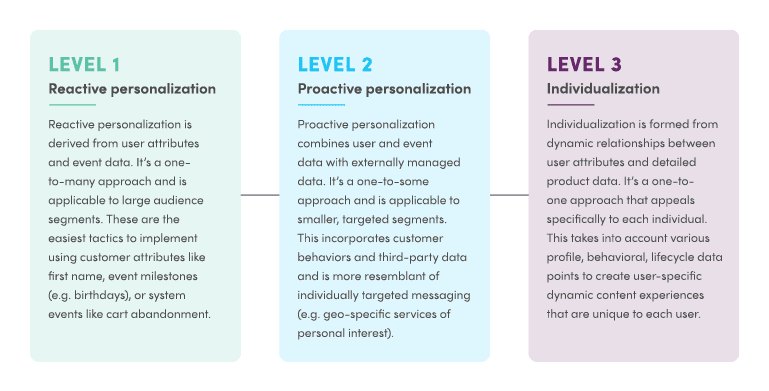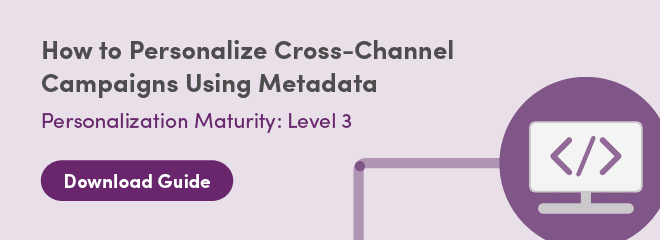Give yourself a pat on the back! You’ve mastered the first two levels of personalization, and you’re almost at the end of your personalization journey. But don’t get too excited just yet because there’s a third and last data type on the block—metadata.
Chances are, you’ve probably heard and used the expression, “That’s so meta,” to describe something that’s self-referential. In the context of advanced cross-channel personalization, your product metadata can be used to take your marketing messages to unprecedented heights and turn your customers into brand evangelists.
But before we divulge further, let’s do a final review of the personalization model.
Final Recap: The Three Levels of Personalization
Take a final look at the personalization maturity model.


Level 1: Reactive personalization
Reactive personalization is derived from user attributes and event data. It’s a one-to-many approach and is applicable to large audience segments. These are the easiest tactics to implement using customer attributes like first name, event milestones (e.g. birthdays), or system events like abandonment.
Level 2: Proactive personalization
Proactive personalization combines user and event data with externally managed data. It’s a one-to-some approach and is applicable to smaller, targeted segments. This incorporates customer behaviors and third-party data and is more resemblant of individually targeted messaging (e.g. geo-specific services of personal interest).
Level 3: Individualization
Individualization is formed from dynamic relationships between user attributes and detailed product data. It’s a one-to-one approach that appeals specifically to each individual. This takes into account various profile, behavioral, lifecycle data points to create user-specific dynamic content experiences that are unique to each user.
How to Level Up
On Level 3, it’s all about forming a 1:1 connection with each customer by honing in on the details that truly matter to them. To illustrate how individualization works, we’ll use a friendship analogy.
Let’s say you meet someone who shares your love of coffee, so you suggest grabbing lattes at a nearby cafe to get to know them better. There, you learn that they recently discovered pour-over coffee after years of brewing in a standard coffee maker.
Based on this newly acquired knowledge, you suggest going to the top three cafes in your area that specialize in this method of brewing coffee, one of which becomes yours and their favorite.
Over time, not only does your friendship deepen but your understanding of your friend’s tastes and preferences also becomes more nuanced and refined. This ultimately means that you can provide highly personalized options—from cafes and types of beans to the equipment they use at home—that appeal the most to your friend.
With this analogy in mind, check out a snippet of our final guide below!
Personalization Maturity, Level 3: Metadata
In the final guide of this three-part series, you’ll get better acquainted with metadata and learn how to harness it in your cross-channel marketing campaigns.
To give you a head start, we’ll share the difference between data feeds and metadata.
- Data feeds are mechanisms to receive real-time information from externally managed websites and apps.
- On the other hand, metadata is descriptive information about your brand’s product or service offerings.
Both can be used to personalize marketing campaigns at the moment of send.
Of course, we’ll provide several examples of metadata in action so you can see how they create individualized messages in the following campaigns:
- Cart abandonment
- Review requests
- Transactional confirmations
- Back-in-stock alerts
- Recommendations
For instance, take a look at Jack Wills’ cart abandonment email campaign.


Source: Really Good Emails
This British fashion and lifestyle brand does a great job of addressing FOMO and incorporating product metadata to re-engage Luke, one of its customers.
For starters, the email headline and message reassure Luke (by name!) that he can return to the website at any time to complete his purchase. The item details (images, names, colors, sizes and prices) help jog his memory of what he had previously looked at. What’s more, the action-oriented CTA and the free delivery are powerful incentives for Luke to complete the transaction.
Overall, this message is friendly, helpful, and not at all pushy. By doing the same, with your product details clearly laid out, you bring your customers one step closer to clicking the ‘checkout’ button on your brand’s website.
We’ve got many more examples to borrow inspiration from, so be sure to download the final guide.
The Challenges of Advanced Personalization—And A Solution
Despite your best efforts, organizational and technological challenges may prevent you from reaching your marketing goals, leaving you to question the value of personalization entirely.
As you’re well aware, abandoning these efforts puts you at a disadvantage among your competitors, and you certainly don’t want to see your hard work go down the drain.
The good news? Iterable offers Catalog, an individualization solution that allows you to deliver powerful and relevant messages at scale with ease.
To learn more, watch Nick Allen, Solutions Consultant at Iterable, demonstrate how to build dynamic content with Catalog in the video below.
Download Part 3 of our cross-channel personalization series to find out how you can use metadata to provide 1:1 experiences for your customers.

































